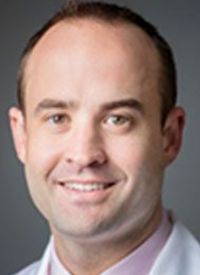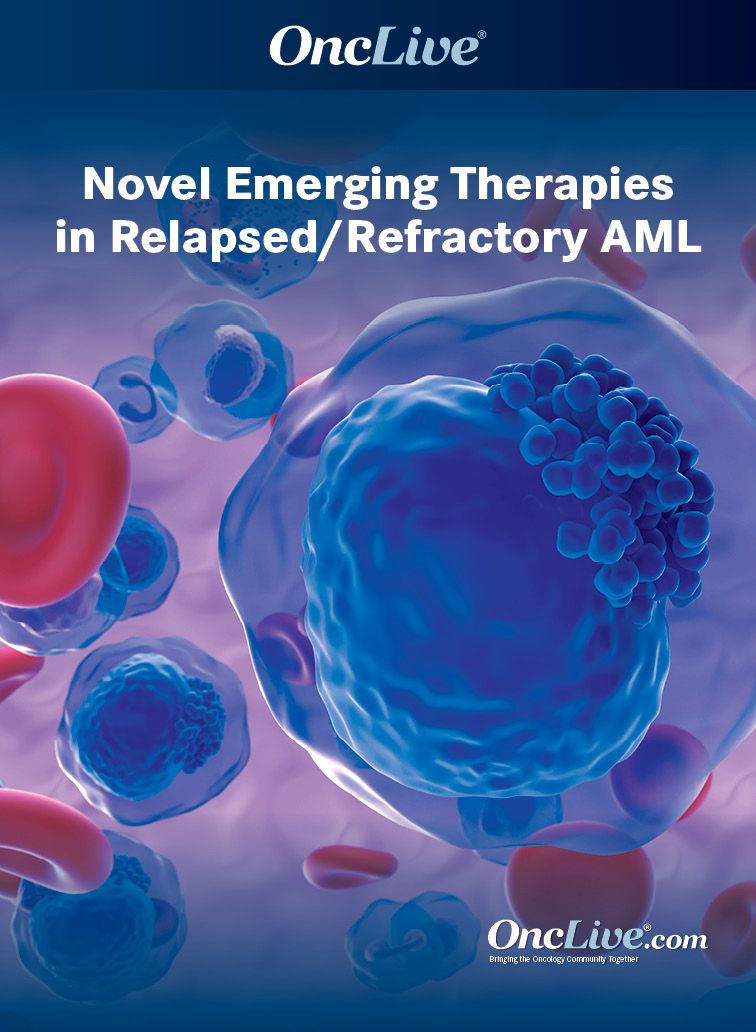Publication
Article
Supplements and Featured Publications
E-Selectin Presents a Favorable Path Forward for AML Populations
Author(s):
In acute myeloid leukemia, investigators are exploring novel agents engineered to target adhesion factors, which can mobilize persistent leukemic stem cells from the bone marrow niche.
David Sallman, MD

Achievement of complete remission (CR) and the depth of that remission are 2 of the most critical needs that investigators seek to address in acute myeloid leukemia (AML). Compared with other leukemias, patients with AML have the lowest 5-year survival rate at 29.5% vs 70.6% for those with chronic lymphocytic leukemia, 87.2% for those with chronic myeloid leukemia, and 69.9% for those with acute lymphocytic leukemia.1-4
Investigators have noted that acquired resistance to standard therapies, such as induction chemotherapy with anthracycline and cytarabine, and the persistence of leukemia stem cells tracked in minimal residual disease (MRD) are 2 hurdles for developing effective treatments for patients.
“Remissions can be achieved with both intensive and nonintensive therapies in sometimes up to 70% of patients [with AML], but a major issue with a vast majority of patients is [relapse] unless they are bridged to allogeneic stem cell transplant,” David Sallman, MD, said in an interview with OncologyLive®. “A big issue is having some leftover amount of disease after frontline therapies, which [is] predictive of poor outcomes even in [individuals] who are ultimately bridged to transplant. Improving the depth of remission and targeting leukemic stem cells that may be left behind [are] of paramount importance to further improve outcomes to therapy.”
Sallman is an assistant member in the Department of Malignant Hematology at Moffitt Cancer Center in Tampa, Florida.
Unmasking Residual Disease With E-Selectin
A recent avenue of exploration for investigators is to inhibit the activity that promotes the self-renewal of leukemic stem cells and draw out persistent cells masked in the bone marrow tumor microenvironment. Specifically, investigators are exploring novel agents engineered to target adhesion factors, which can mobilize persistent leukemic stem cells from the bone marrow niche.5
“Normal hematopoietic stem cells reside in the bone marrow in these specialized microenvironments, which refer to the stem cell niche,” Geoffrey L. Uy, MD, said in an interview. “Evidence suggests that leukemia stem cells occupy specific niches within the bone marrow. This interaction confers protection against genotoxic stresses, such as chemotherapy.”
Uy is a professor of medicine in the Division of Oncology, Section of Bone Marrow Transplantation at Washington University School of Medicine in St Louis and a bone marrow transplant specialist and medical oncologist at Siteman Cancer Center in Missouri.
One adhesion molecule and associated pathway of interest is E-selectin, which is expressed on the vascular endothelium and has known interactions with leukemic stems cells through binding with ligands such as CD44. Activation of the E-selectin pathway induces activity that can result in the protection of these cells and the promotion of cytotoxic chemotherapy resistance.6,7
“E-selectin is normally expressed on endothelial cells and is upregulated in response to inflammation, which includes IL-1, tumor necrosis factor, and lipopolysaccharide,” Uy explained. “When E-selectin is upregulated, it binds to E-selectin ligands present on leukocytes and is an important mechanism for these leukocytes to traffic to areas of inflammation. In the bone marrow microenvironment, we know that E-selectin is present in the bone marrow sinusoids. It is expressed at high levels, and the E-selectin ligands are expressed on tumor cells. We think that this interaction confers specific protective effects to these AML blasts, and plenty of data have shown that specific pathways are activated, such as PI3K, AKT, and NFκB, that can be important for leukemia cell survival.”
Disrupting the E-selectin pathway opens the door for investigators to capitalize on the known effects of intensive chemotherapy regimens, such as MEC (mitoxantrone, etoposide, and cytarabine). An agent of interest in this space is the novel E-selectin antagonist uproleselan. Investigators have observed preclinical and clinical activity of uproleselan in combination with MEC, specifically in a phase 1/2 study (NCT02306291) in a cohort of older patients (aged ≥ 60 years) with newly diagnosed AML and in a cohort of patients with relapsed or refractory AML, administered in the salvage setting.8
Uproleselan Clears the Path for Chemotherapy
The treatment schema for the phase 1/2 trial called for the administration of uproleselan 24 hours prior to chemotherapy, followed by twice daily during chemotherapy, and twice daily 48 hours following induction chemotherapy as a 20-minute intravenous (IV) infusion. Three doses of uproleselan were assessed, and the recommended phase 2 dose (RP2D) was determined as 10 mg/kg because it did not result in dose-limiting toxicities in more than 33% of patients.8
Induction chemotherapy regimens in the trial were as follows: Patients with relapsed/refractory AML received standard MEC (daily mitoxantrone 10 mg/m2 via 15-20 minute IV, daily etoposide 100 mg/m2 IV over 60 minutes, and daily cytarabine 1000 mg/m2 IV over 60 minutes for 5 days), and older patients with newly diagnosed AML received conventional 7+3 induction chemotherapy (24-hour continuous daily infusion of cytarabine 200 mg/m2 on days 1-7 in combination with 12 mg/m2 idarubicin on days 1-3 via daily IV bolus).8 Induction therapy lasted 8 days and 10 days, respectively. If remission was achieved, patients were offered optional consolidation therapy.
Among those treated with the RP2D in the relapsed/refractory cohort (n = 54), the overall response rate (ORR) was 41%, with 35% of patients reporting a CR and 10 patients having a response lasting at least 12 months. Thirteen patients were evaluable for MRD analysis, with 4 patients identified as MRD positive and 9 as MRD negative, which was defined as having at least 10-3 leukemic cells.8
The median overall survival (OS) was 8.8 months (95% CI, 9.7-11.4), and the median event-free survival (EFS) was 1.5 months (95% CI, 1.3-2.8). Notably, when assessed by E-selectin ligand expression, those with at least 10% expression (n = 21) had a greater median OS (10.7 months; 95% CI, 5.9-not applicable [NA]) vs those with 10% expression or less (5.2 months; 95% CI, 0.9-9.4]). This benefit extended to those who had a CR lasting at least 12 months and to those who underwent transplant following uproleselan.8
In the cohort of older patients (n=25), the ORR was 72% with a CR rate of 52%. Among those evaluable for MRD assessment, 4 patients were positive and 5 were negative. The median OS was 12.6 months (95% CI, 9.9-NA), and the median EFS was 9.2 months (95% CI, 3.0-12.6).8
In terms of safety, the agent was well tolerated and demonstrated no clear additive toxicities.
“There are no significant drug interactions [with chemotherapy], such as QT prolongation or CYP3A4 interactions,” Uy said about the phase 1/2 data. “[Uproleselan] is easy to add to different chemotherapy backbones. One of the potential benefits of this drug is that it may protect patients against chemotherapy-induced mucositis. Gastrointestinal toxicity can be quite significant in patients receiving induction chemotherapy for leukemia, [and uproleselan] may protect against [this] important cause of morbidity in this population.”
Leveraging these findings, trials have commenced to further explore the efficacy of uproleselan in both populations. “The major key when you’re thinking of any trial in the intensive chemotherapy option is really a randomized trial,” Sallman said, noting that the phase 3 trial in the relapsed/refractory patient population will be of particular interest because those who progress following more than 1 line of therapy have the worst outcomes.
Unpacking the Role of Uproleselan Across AML
Investigators have expanded the scope of this evaluation with the initiation of the phase 3 GMI-1271-301 trial (NCT03616470).9 The phase 3 study is designed to evaluate chemotherapy with either uproleselan or placebo in patients with relapsed/refractory AML. Enrollment was completed in November 2021.10
Patients were randomly assigned to receive uproleselan or placebo in combination with 1 cycle of induction MEC or fludarabine, cytarabine, and idarubicin. Consolidation therapy, which can last up to 3 cycles, will consist of either uproleselan or placebo in combination with high-dose or intermediate-dose cytarabine (Figure).9 The primary end point of the study is OS. Secondary outcome measures include ORR and rate of severe oral mucositis following treatment. EFS, duration of remission, and safety will also be assessed.
Investigators are also seeking to explore the efficacy of uproleselan in the secondary cohort of patients from the phase 1/2 study—those with newly diagnosed AML who are 60 years and older and fit for 7 + 3 chemotherapy11—in the phase 2/3 A041701 (NCT03701308) trial. Sponsored by the National Cancer Institute and the Alliance for Clinical Trials in Oncology, the study completed enrollment at the end of 2021. Patients were randomly assigned to 7 + 3 chemotherapy with or without uproleselan. If CR was achieved, patients proceeded to consolidation therapy; those without CR proceeded to a second induction cycle. The primary end point of the phase 2 portion of the trial is EFS. Should the results meet the prespecified end point, the data will transfer confidentially to GlycoMimetics Inc, the developer of the agent, to support filing for FDA approval.11
References
- Cancer stat facts: leukemia — acute myeloid leukemia (AML). National Cancer Institute Surveillance, Epidemiology, and End Results Program. Accessed March 17, 2022. https://seer.cancer.gov/statfacts/html/amyl.html
- Cancer stat facts: leukemia — chronic myeloid leukemia (AML). National Cancer Institute Surveillance, Epidemiology, and End Results Program. Accessed March 17, 2022. https://seer.cancer.gov/statfacts/html/cmyl.html
- Cancer stat facts: leukemia — chronic lymphocytic leukemia (CLL). National Cancer Institute Surveillance, Epidemiology, and End Results Program. Accessed March 17, 2022. https://seer.cancer.gov/statfacts/html/clyl.html
- Cancer stat facts: leukemia — acute lymphocytic leukemia (ALL). National Cancer Institute Surveillance, Epidemiology, and End Results Program. Accessed March 17, 2022. https://seer.cancer.gov/statfacts/html/alyl.html
- Yao Y, Li F, Huang J, Jin J, Wang H. Leukemia stem cell-bone marrow microenvironment interplay in acute myeloid leukemia development. Exp Hematol Oncol. 2021;10(1):39. doi:10.1186/s40164-021-00233-2
- Maiti A, Daver NG. A nonstick marrow may help to fry leukemia. Blood. 2022;139(8):1119-1121. doi:10.1182/blood.2021013965
- van Gils N, Denker F, Smit L. Escape from treatment; the different faces of leukemic stem cells and therapy resistance in acute myeloid leukemia. Front Oncol. 2021;11:659253. doi:10.3389/fonc.2021.659253
- DeAngelo DJ, Jonas BA, Liesveld JL, et al. Phase 1/2 study of uproleselan added to chemotherapy in patients with relapsed or refractory acute myeloid leukemia. Blood. 2022;139(8):1135-1146. doi:10.1182/blood.2021010721
- Study to determine the efficacy of uproleselan (GMI-1271) in combination with chemotherapy to treat relapsed/refractory acute myeloid leukemia. ClinicalTrials.gov. Updated November 18, 2021. Accessed March 19, 2022. https://clinicaltrials.gov/ct2/show/NCT03616470
- GlycoMimetics completes enrollment of phase 3 registration trial evaluating lead candidate uproleselan in patients with relapsed/refractory acute myeloid leukemia (AML). News release. GlycoMimetics Inc. November 15, 2021. Accessed March 19, 2022. bwnews.pr/3CYYB4K
- NCI-sponsored trial of uproleselan in older, newly diagnosed AML patients fit for intensive chemotherapy completes enrollment of phase 2 portion ahead of schedule. News release. GlycoMimetics Inc. December 6, 2021. Accessed March 19, 2022. bwnews.pr/3ipZr13










